An Energy-Efficient Routing Protocol for Reliable Data Transmission in Wireless Body Area Networks
Abstract
:1. Introduction
- (1)
- A maximum benefit function is constructed to dynamically select the next hop node with the good state. The function takes multiple parameters into account, such as the remaining energy, transmission efficiency, available bandwidth and hops from the sink, which can achieve reliable multi-hop data transmission.
- (2)
- Based on the different priority data of WBAN, we dynamically adjust the weight of the maximum benefit function to achieve timely and reliable transmission of emergency data and also satisfy the Qos requirements of periodic data.
- (3)
- A simulation experiment platform was established to compare the proposed protocol with the PERA and NEW-ATTEMPT routing protocols. The experiment shows that the proposed protocol has significant advantages in prolonging network lifetime and reliable data transmission.
2. Related Works
3. System Model
3.1. Network Model
- (1)
- All sensor nodes are distributed in the corresponding position of the human body according to their different functions. After placement, all sensor nodes have their own ID and their positions remain unchanged.
- (2)
- The initial energy of each node is equal, and all nodes have data fusion function. At the same time, the transmitting power can be dynamically adjusted, and the maximum wireless transmission distance is R.
- (3)
- When the node is sleeping, the wireless module is closed and the low-energy detection module is still working.
- (4)
- According to the actual situation, the energy of the sink node is not considered or assumed to be infinite, and it has strong information-processing ability.
3.2. Energy Consumption Model
4. Energy-Efficient Routing Protocol for Reliable Data Transmission in WBAN
4.1. Construction of the Maximum Benefit Function
4.2. Routing Process
4.2.1. Network Initialization
4.2.2. Next Hop Node Selection Based on Maximum Benefit Function
| Algorithm 1: Dynamically select weight values for different priority data |
| Input: node ; |
| Output: the weight value for the data of node ; |
| Process: |
| 1: if node has packet to send then |
| 2: Judge the priority of the packet; |
| 3: else 4: end 5: end if 6: if the packet belongs to P1 priority then |
| 7: Select the weight value for P1 priority; |
| 8: else |
| 9: Select the weight value for P2 priority; |
| 10: end if |
| 11: Retune the weight value for the data of node ; |
| Algorithm 2: The best next hop selection procedure |
| Input:S: source node, Sink: coordinator, : cost function of node , NT: neighbor table; |
| Output:N-best (): the best next hop node for |
| Process: |
| 1: Start |
| 2: for S has packets to transmit with Sink then |
| 3: Select the best next hop from NT; |
| 4: for each record in NT to |
| 5: Calculate ; |
| 6: List the set of ← value of each record in NT; |
| 7: N-best ()←max {} |
| 8: end for |
| 9: end for |
| 10: end |
4.2.3. Data Forwarding
5. Experimental Results
6. Conclusions
Author Contributions
Funding
Acknowledgments
Conflicts of Interest
References
- Ghamari, M.; Janko, B.; Sherratt, R.S.; Harwin, W.; Piechockic, R.; Soltanpur, C. A Survey on Wireless Body Area Networks for eHealthcare Systems in Residential Environments. Sensors 2016, 16, 831. [Google Scholar] [CrossRef] [PubMed]
- Meharouech, A.; Elias, J.; Mehaoua, A. Moving Towards Body-to-Body Sensor Networks for Ubiquitous Applications: A Survey. J. Sens. Actuator Netw. 2019, 8, 27. [Google Scholar] [CrossRef]
- Dhanvijay, M.M.; Patil, S.C. Internet of Things: A survey of enabling technologies in healthcare and its applications. Comput. Netw. 2019, 153, 113–131. [Google Scholar] [CrossRef]
- Qu, Y.; Zheng, G.; Ma, H.; Wang, X.; Ji, B.; Wu, H. A Survey of Routing Protocols in WBAN for Healthcare Applications. Sensors 2019, 19, 1638. [Google Scholar] [CrossRef] [PubMed]
- Abdelrahman, M.; Mohamed, S.; Bassem, M. Adaptive Dynamic Routing for IEEE 802.15.6 Wireless Body Area Networks. In Proceedings of the 35th National Radio Science Conference (NRSC), Misr Int Univ, Cairo, Egypt, 20–22 March 2018; pp. 170–176. [Google Scholar]
- Ghufran, A.; Saif, U.; Maham, S. Rigorous Analysis and Evaluation of Specific Absorption Rate (SAR) for Mobile Multimedia Healthcare. IEEE Access 2018, 6, 29602–29610. [Google Scholar]
- Murtaza, C.; Ali, C. Dynamic HUB Selection Process Based on Specific Absorption Rate for WBANs. IEEE Sens. J. 2019, 19, 5718–5722. [Google Scholar]
- Jin, X.; Yi, X. A transmission-reliable energy-consumption balanced routing protocol for WSNs. Transducer Microsyst. Technol. 2018, 10, 47–49, 53. [Google Scholar]
- Ernesto, I.; Angelos, A.; Elli, K. QoS-Aware Energy Management in Body Sensor Nodes Powered by Human Energy Harvesting. IEEE Sens. J. 2016, 2, 542–549. [Google Scholar]
- Hu, F.; Liu, X.; Shao, M. Wireless Energy and Information Transfer in WBAN: An Overview. IEEE Netw. 2017, 3, 90–96. [Google Scholar] [CrossRef]
- Mahircan, D.S.; Fadi, A.; Ali, M. Energy Scavenging Methods for WBAN Applications: A Review. IEEE Sens. J. 2018, 16, 6477–6488. [Google Scholar]
- Bhanumathi, V.; Sangeetha, C.P. A guide for the selection of routing protocols in WBAN for healthcare applications. Hum. Cent. Comput. Inf. Sci. 2017, 7, 1–19. [Google Scholar] [CrossRef]
- Kento, T.; Hirokazu, T.; Chika, S. Performance Evaluation of a Quality of Service Control Scheme in Multi-Hop WBAN Based on IEEE 802.15.6. Sensors 2018, 11, 3969. [Google Scholar]
- Moid, S.M.; Nadeem, J.; Muhammad, I. BEC: A Novel Routing Protocol for Balanced Energy Consumption in Wireless Body Area Networks. In Proceedings of the 11th IEEE International Wireless Communications and Mobile Computing Conference (IEEE IWCMC), Dubrovnik, Croatia, 24–25 August 2015; pp. 653–658. [Google Scholar]
- Ahmed, G.; Jianhua, Z.; Fareed, M.M.S. PERA: Priority-Based Energy-Efficient Routing Algorithm for WBANs. Wirel. Pers. Commun. 2017, 96, 4737–4753. [Google Scholar] [CrossRef]
- Jamil, F.; Iqbal, M.A.; Amin, R.; Kim, D. Adaptive Thermal-Aware Routing Protocol for Wireless Body Area Network. Electronics 2019, 8, 47. [Google Scholar] [CrossRef]
- Bhangwar, A.R.; Kumar, P.; Ahmed, A.; Channa, M.I. Trust and Thermal Aware Routing Protocol (TTRP) for Wireless Body Area Networks. Wirel. Pers. Commun. 2017, 97, 349–364. [Google Scholar] [CrossRef]
- Khanna, A.; Chaudhary, V.; Gupta, S.H. Design and Analysis of Energy Efficient Wireless Body Area Network (WBAN) for Health Monitoring. Trans. Comput. Sci. XXXIII 2018, 10990, 25–39. [Google Scholar]
- Smita, S.; Sarita, N.; Anchal, U. Modified New-Attempt Routing Protocol for Wireless Body Area Network. In Proceedings of the 2nd International Conference on Advances in Computing, Communication, and Automation (ICACCA), Bareilly, India, 30 September–1 October 2016; pp. 156–160. [Google Scholar]
- Su, K.B.; Babar, S.; Feras, A.O. An Enhanced Mobility and Temperature Aware Routing Protocol through Multi - Criteria Decision Making Method in Wireless Body Area Networks. Appl. Sci. 2018, 11, 2245. [Google Scholar]
- Ghufran, A.; Danish, M.; Saiful, I. Thermal and energy aware routing in wireless body area networks. Int. J. Distrib. Sens. Netw. 2019, 6, 1–12. [Google Scholar]
- Anwar, M.; Abdullah, A.H.; Altameem, A.; Qureshi, K.F.; Masud, F.; Faheem, M.; Cao, Y.; Kharel, R. Green Communication for Wireless Body Area Networks: Energy Aware Link Efficient Routing Approach. Sensors 2018, 18, 3237. [Google Scholar] [CrossRef]
- Sangwan, A.; Bhattacharya, P.P. Reliable Energy Efficient Multi-Hop Routing Protocol for Heterogeneous Body Area Networks. Int. J. Sens. Wirel. Commun. Control. 2018, 8, 47–56. [Google Scholar] [CrossRef]
- Peng, Y.; Zhang, S. Research on Energy Consumption Control Routing Algorithm for Wireless Body Area Network. Softw. Guide 2017, 12, 90–93. [Google Scholar]
- Gu, Z.; Peng, H.; Wu, Y. Key Problem of Human-Body Communication over Wireless Body Area Network. Commun. Technol. 2017, 50, 1968–1975. [Google Scholar]
- Khan, R.A.; Mohammadani, K.H.; Soomro, A.A. An Energy Efficient Routing Protocol for Wireless Body Area Sensor Networks. Wirel. Pers. Commun. 2018, 99, 1443–1454. [Google Scholar] [CrossRef]
- Hojjatollah, E.; Minaei, B.B. EMRP: Evolutionary-based multi-hop routing protocol for wireless body area networks. Aeu-Int. J. Electron. Commun. 2018, 93, 63–74. [Google Scholar]
- Kathe, K.S.; Deshpande, U.A. A Thermal Aware Routing Algorithm for a Wireless Body Area Network. Wirel. Pers. Commun. 2019, 4, 1353–1380. [Google Scholar] [CrossRef]
- Zahid, U.; Imran, A.; Tamleek, A. Robust and Efficient Energy Harvested-Aware Routing Protocol with Clustering Approach in Body Area Networks. IEEE Access 2019, 7, 33906–33921. [Google Scholar]
- Bhangwar1, A.R.; Ahmed, A.; Khan, U.A.; Saba, T.; Almustafa, K.; Haseeb, H.; Islam, N. WETRP: Weight based Energy & Temperature aware Routing Protocol for Wireless Body Sensor Networks. IEEE Access (Early Access) 2019, 7, 87987–87995. [Google Scholar]
- Hu, D.; Wu, J.; Fan, P. Maximizing End-to-End Throughput of Interference-Limited Multihop Networks. IEEE Trans. Veh. Technol. 2018, 67, 5465–5469. [Google Scholar] [CrossRef]
- Heinzelman, W.; Chandrakasan, A.; Balakrishnan, H. An application-specific protocol architecture for wireless micro sensor networks. IEEE Trans. Wirel. Commun. 2002, 1, 660–670. [Google Scholar] [CrossRef]
- Maham, W.; Rizwan, A.; Waqas, A. Towards Efficient Wireless Body Area Network Using Two-Way Relay Cooperation. Sensors 2018, 2, 565. [Google Scholar]
- Mu, J.; Stewart, R.; Han, L.; Crawford, D. A Self-Organized Dynamic Clustering method and its Multiple Access Mechanism for Multiple WBANs. IEEE Internet Things J. (Early Access) 2019, 6, 6042–6051. [Google Scholar] [CrossRef]
- Liang, Z.; Yao, Y. Study of energy efficient WBAN topology optimization in IEEE 802.15.6. J. Commun. 2016, 37, 1–10. [Google Scholar]
- Kadel, R.; Islam, N.; Ahmed, K.; Halder, S.J. Opportunities and Challenges for Error Correction Scheme for Wireless Body Area Network—A Survey. J. Sens. Actuator Netw. 2019, 8, 1. [Google Scholar] [CrossRef]
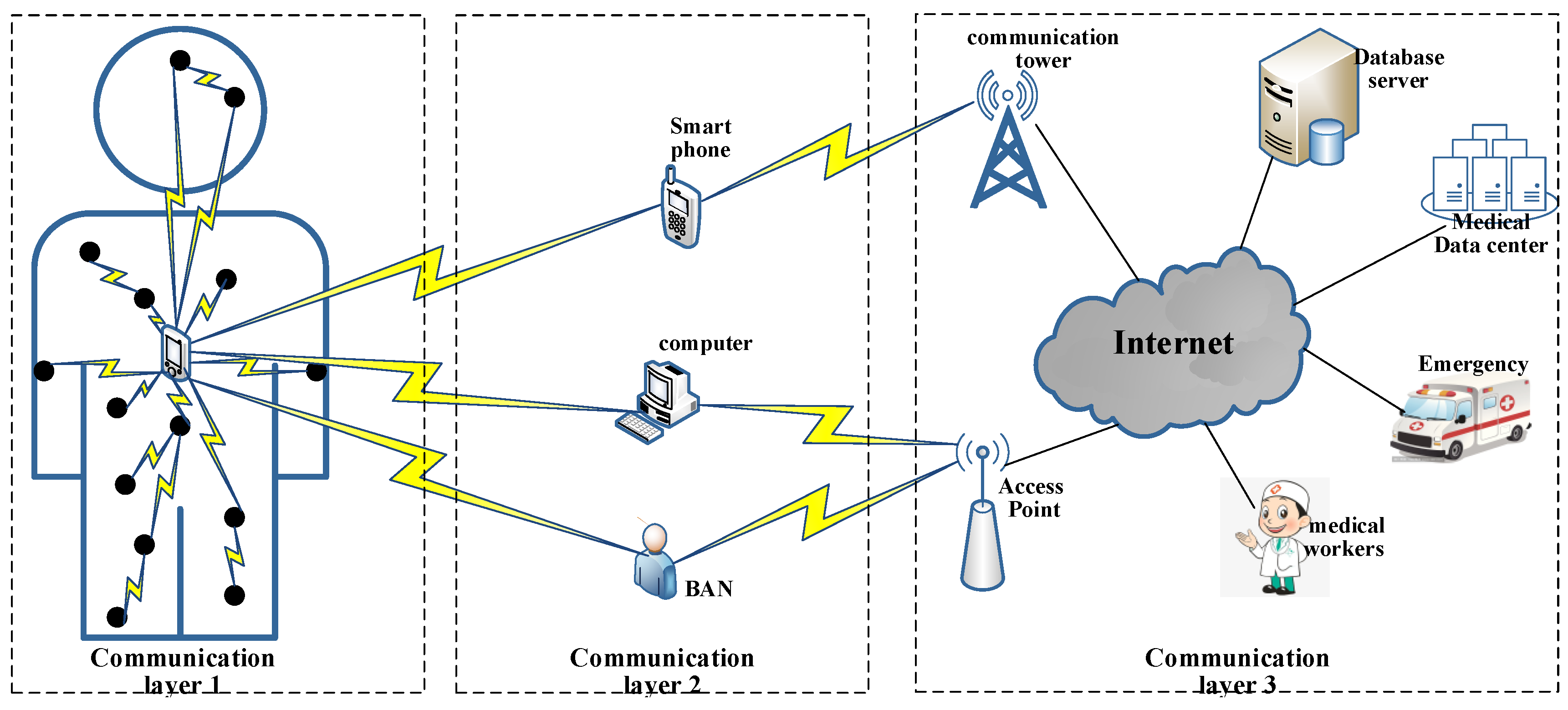


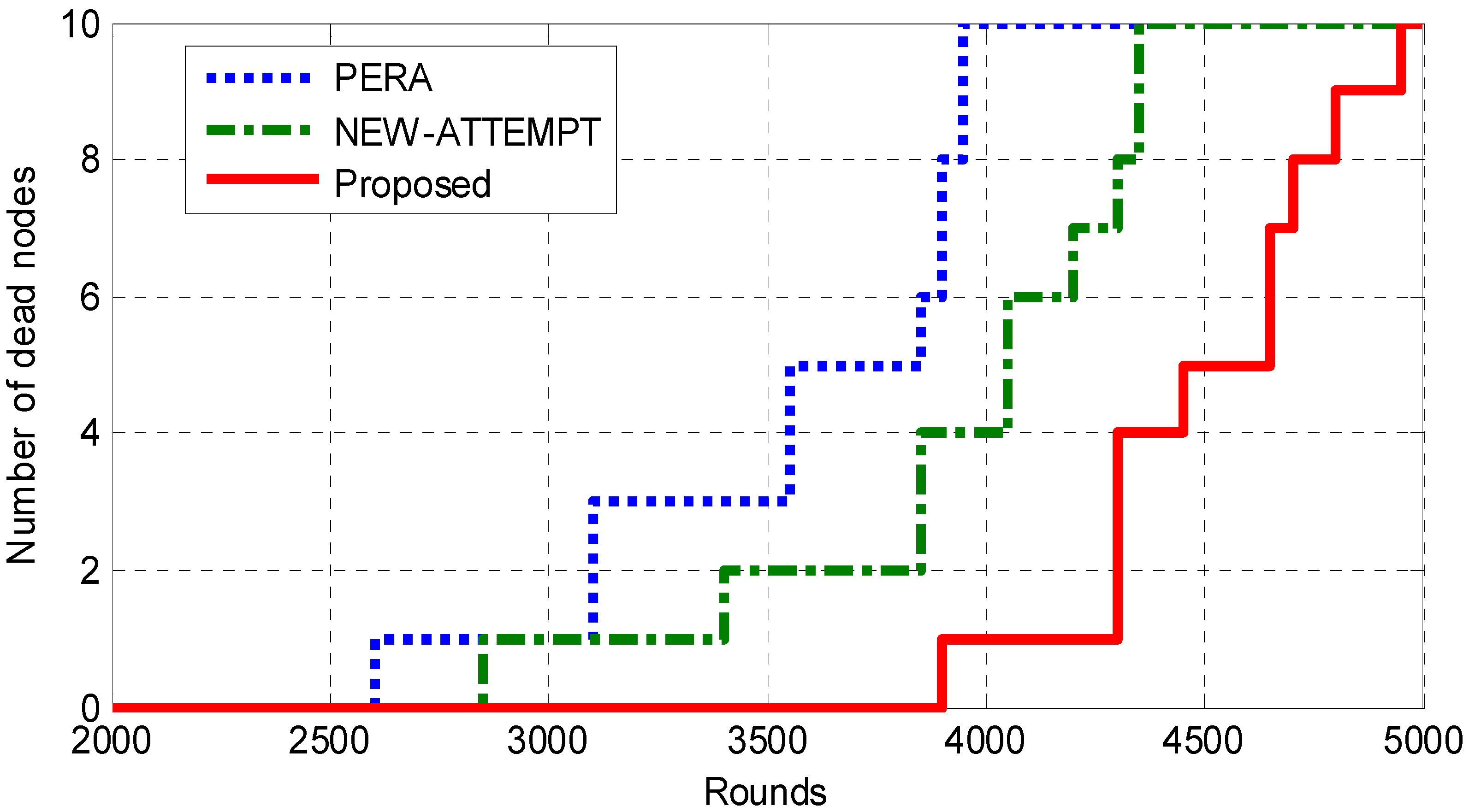
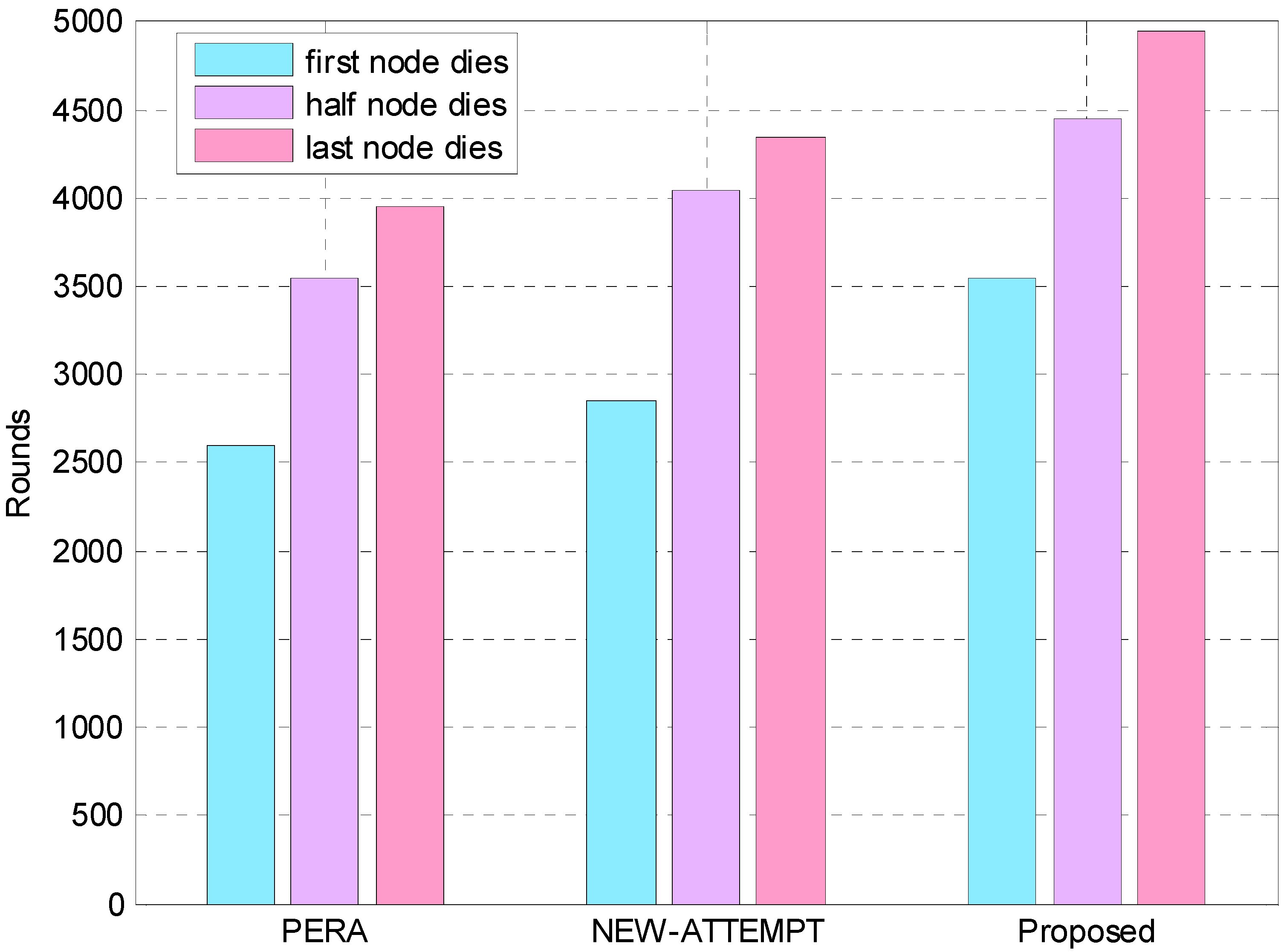
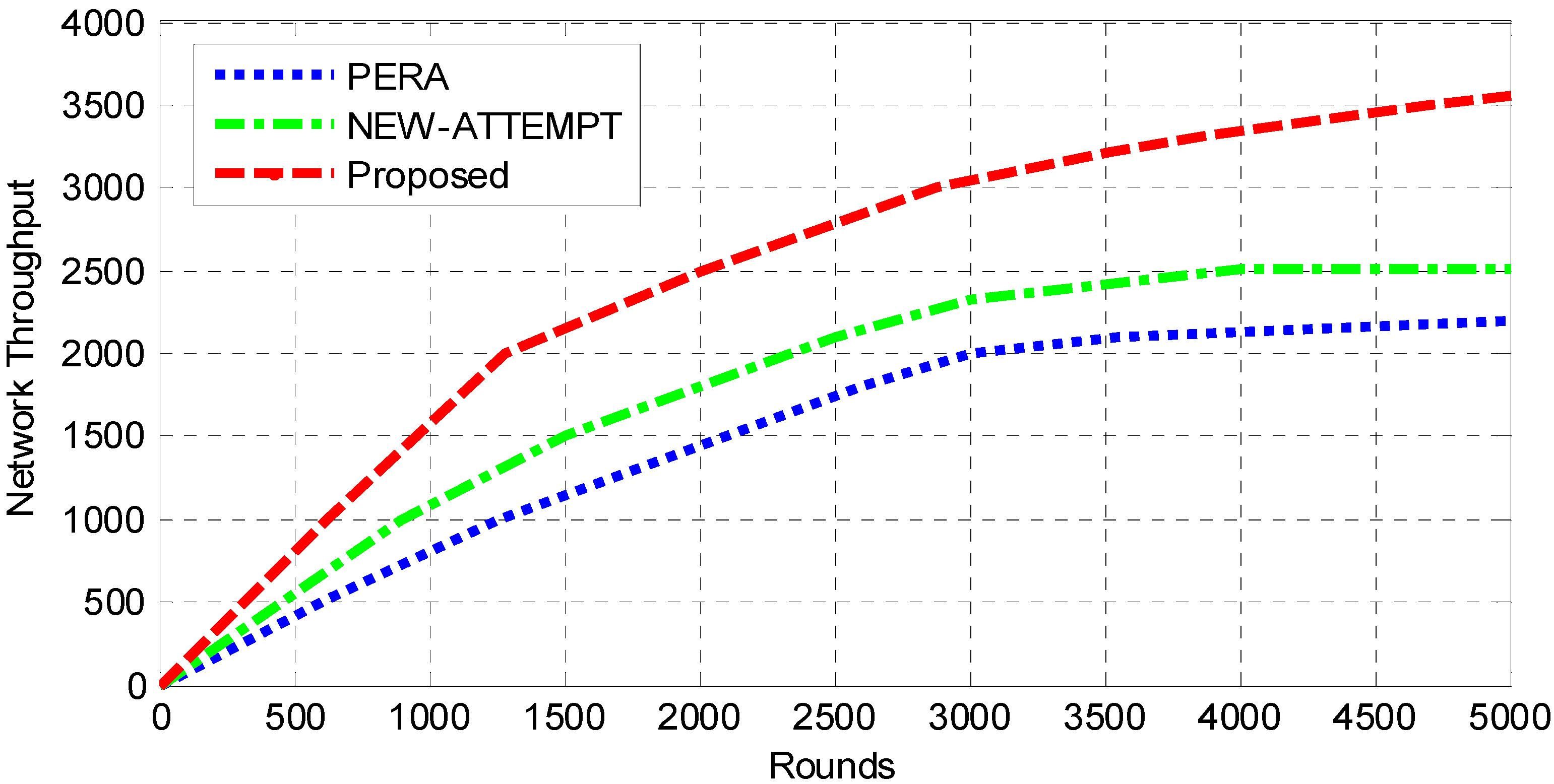

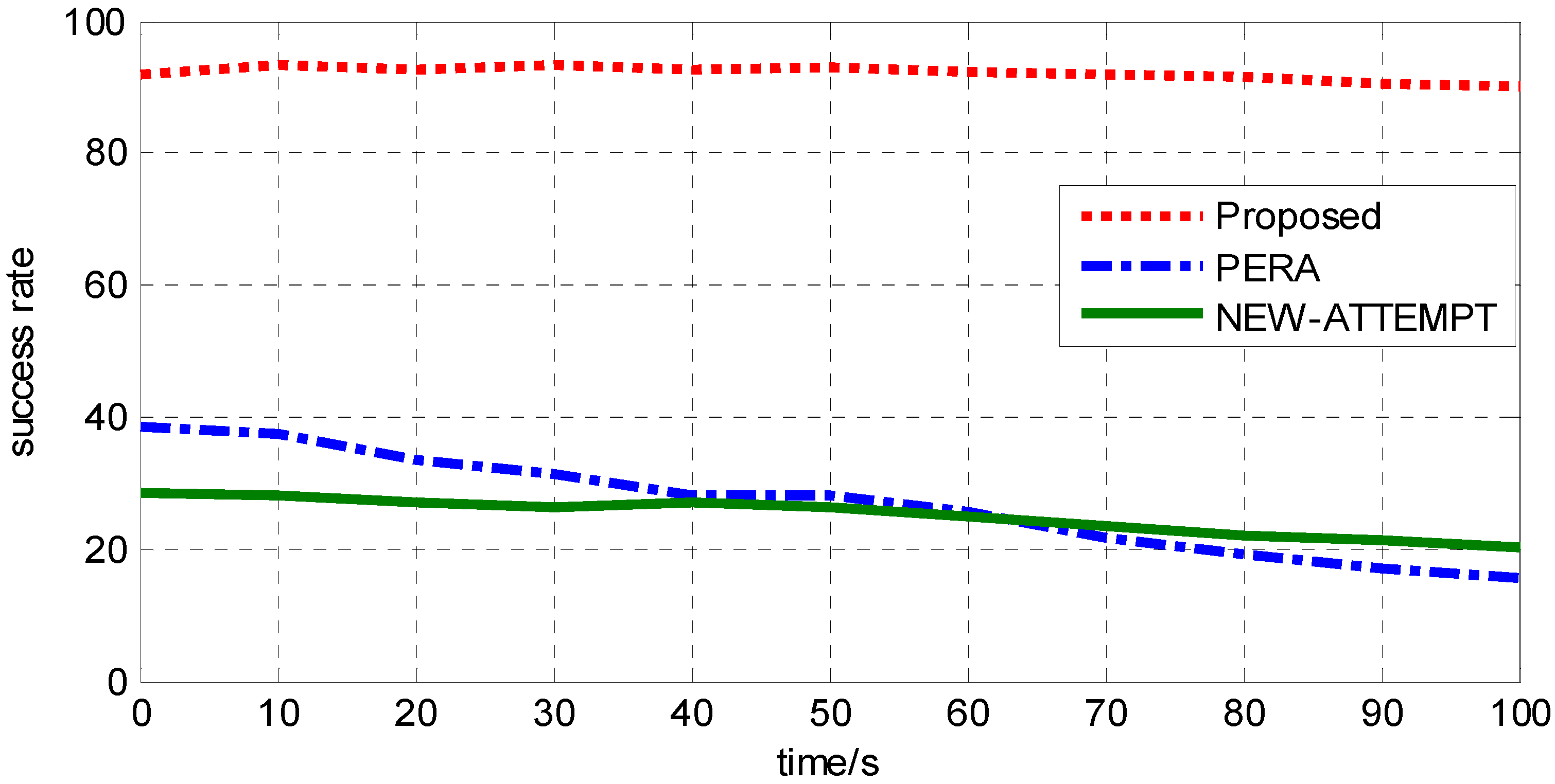
| Parameter | Value |
|---|---|
| Number of nodes | 10 |
| Number of Sink | 1 |
| Initial energy | 0.5 J |
| Size of a packet | 50 bits |
| 16.7 nJ/bit | |
| 36.1 nJ/bit | |
| 1.97 nJ/bit/mn |
© 2019 by the authors. Licensee MDPI, Basel, Switzerland. This article is an open access article distributed under the terms and conditions of the Creative Commons Attribution (CC BY) license (http://creativecommons.org/licenses/by/4.0/).
Share and Cite
Qu, Y.; Zheng, G.; Wu, H.; Ji, B.; Ma, H. An Energy-Efficient Routing Protocol for Reliable Data Transmission in Wireless Body Area Networks. Sensors 2019, 19, 4238. https://doi.org/10.3390/s19194238
Qu Y, Zheng G, Wu H, Ji B, Ma H. An Energy-Efficient Routing Protocol for Reliable Data Transmission in Wireless Body Area Networks. Sensors. 2019; 19(19):4238. https://doi.org/10.3390/s19194238
Chicago/Turabian StyleQu, Yating, Guoqiang Zheng, Honghai Wu, Baofeng Ji, and Huahong Ma. 2019. "An Energy-Efficient Routing Protocol for Reliable Data Transmission in Wireless Body Area Networks" Sensors 19, no. 19: 4238. https://doi.org/10.3390/s19194238
APA StyleQu, Y., Zheng, G., Wu, H., Ji, B., & Ma, H. (2019). An Energy-Efficient Routing Protocol for Reliable Data Transmission in Wireless Body Area Networks. Sensors, 19(19), 4238. https://doi.org/10.3390/s19194238




